What is Integration Testing? A Comprehensive Guide.
Pritpal Singh
Mar 21, 2024
Introduction
In software development, ensuring that individual components work together flawlessly is paramount. This is where integration testing comes into play. But what exactly is integration testing? Simply put, it verifies that your application's different modules or services work well together.
Integration testing is a crucial phase in the software testing lifecycle, where individual software modules are combined and tested as a group. The purpose is to expose faults in the interaction between these software modules when integrated.
This blog post will dive deep into the concept of integration testing, its types, processes, challenges, and best practices. By the end, you'll understand how integration testing can ensure your software's seamless functionality.
Understanding Integration Testing
Integration testing focuses on verifying the communication between two or more units of an application. Unlike unit testing, which tests modules in isolation, integration testing is performed to expose defects in the interfaces and interactions between modules when they are integrated.
Integration testing aims to validate that integrated components work correctly together as expected, without issues such as data corruption, interface mismatch, or performance degradation. By identifying these problems early, integration testing prevents them from being discovered in later stages of the software development lifecycle (SDLC), where they are more expensive to fix.
In the context of the SDLC, integration testing is typically performed after unit testing and before system testing. Unit testing ensures that individual components work in isolation, while system testing verifies the entire system's functionality. Integration testing bridges the gap between these two stages.
Here are a few software products/SaaS that have benefited from integration testing:
These examples demonstrate how integration testing has helped improve various aspects of software products and SaaS, including data integrity, reliability, compatibility, user experience, and security. By investing in comprehensive integration testing, these companies have delivered their users high-quality, seamless software functionality.
| Software/SaaS | Improvement Type | Source |
|---|---|---|
| Salesforce | Enhanced data integrity and consistency across modules | Salesforce Integration Testing |
| Netflix | Improved reliability and fault tolerance of microservices architecture | Netflix Automated Testing |
| Stripe | Ensured smooth integration with third-party payment gateways and APIs | Stripe Testing Strategy |
| Dropbox | Guaranteed seamless synchronization and data consistency across devices | Dropbox Integration Testing |
| Airbnb | Streamlined booking process and reduced errors through integration testing | Airbnb Continuous Integration and Deployment |
| Uber | Enhanced reliability and performance of distributed systems and microservices | Uber Microservice Architecture Testing |
| Slack | Improved compatibility and smooth integration with third-party apps and services | Slack API Testing |
| Spotify | Ensured seamless user experience across different devices and platforms | Spotify Testing Strategy |
| Shopify | Guaranteed reliable integration with various payment processors and shipping providers | Shopify Integration Testing |
| GitHub | Enhanced security and reliability of code integration and deployment processes | GitHub Testing Strategy |
Types of Integration Testing
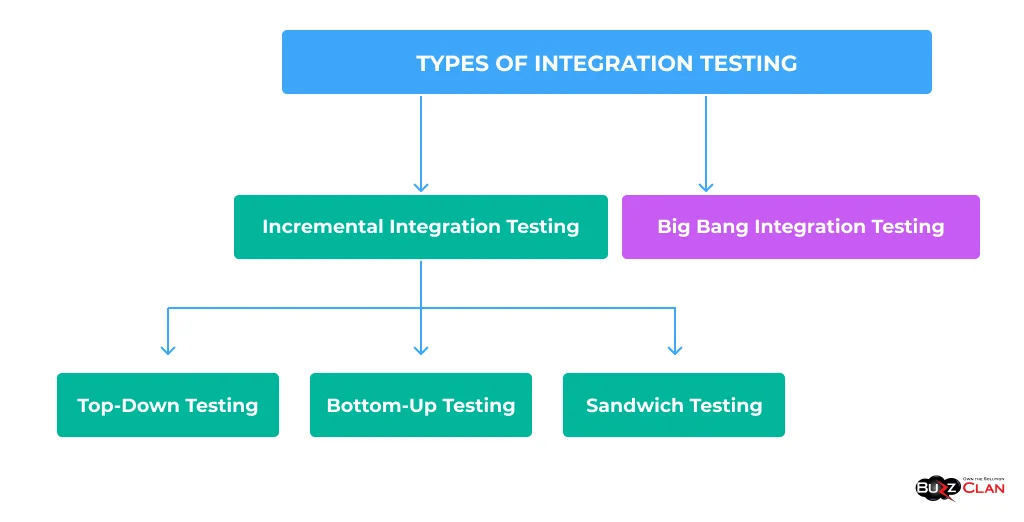
There are several approaches to integration testing, each with its advantages and use cases:
Big Bang Integration Testing
In this approach, all components are integrated simultaneously, and testing is performed. This method suits small systems but can become complicated for larger applications.
Incremental Integration Testing
This approach involves integrating and testing components individually, gradually building the system. There are three main incremental integration strategies:
- Top-Down Testing: Testing starts from the top of the hierarchy and moves downwards, replacing lower-level components with stubs.
- Bottom-Up Testing: Testing starts from the bottom of the hierarchy and moves upwards, replacing higher-level components with drivers.
- Sandwich Testing: A combination of top-down and bottom-up testing, where testing starts from both ends of the hierarchy and moves towards the middle.
The choice of integration testing approach depends on factors such as system complexity, available resources, and project deadlines.
The Process of Integration Testing
Effective integration testing starts with a well-defined test plan and strategy. The test plan outlines the testing process's scope, objectives, resources, and schedule. It also defines the entry and exit criteria for each stage of testing.
Designing integration test cases is a critical part of the planning process. Test cases should cover all possible scenarios, including positive and negative cases, boundary values, and error conditions. They should also consider the dependencies and interactions between modules.
Some key considerations while planning integration testing include:
- Identifying the modules to be integrated and the order of integration
- Defining the test environment and tools required
- Establishing the input data and expected outputs for each test case
- Setting up the test data and any necessary stubs or drivers
- Determining the acceptance criteria for each test case
Executing Integration Tests
Once the test plan and test cases are ready, the next step is to execute the integration tests. The execution involves the following steps:
- Set up the test environment, including hardware, software, and network configurations.
- Integrate the modules to be tested, following the defined order of integration.
- Run the test cases and record the results, including any discrepancies or issues found.
- Analyze the results and identify any defects or areas for improvement.
- Debug, fix the identified issues, and retest to ensure they are resolved.
- Repeat the process until all test cases pass and the acceptance criteria are met.
To streamline the execution process, many organizations use automated testing tools. These tools can reduce the time and effort required for testing, improve test coverage, and ensure consistent results. Some popular integration testing tools include Jenkins, GitLab CI/CD, Bamboo, and Travis CI.
Comparing Testing Methodologies : Unit Testing vs. Integration Testing
Unit testing and integration testing are two essential types of software testing that play distinct roles in ensuring the quality of a software application.
Unit testing, often performed by developers during the development process, involves isolating individual application units or modules and testing their functionality in isolation. The purpose is to verify that each unit performs as expected and meets its design specifications. Developers typically write unit tests and run them frequently throughout the development lifecycle to catch issues early.
On the other hand, integration testing, usually conducted by a separate quality assurance (QA) team after the development process, focuses on testing how different units or modules of an application interact. It checks that when these units are integrated, they work together correctly, communicate effectively, and exchange data as intended. Integration testing helps identify issues related to interdependencies between different components and ensures that the overall system functions as expected.
While both unit and integration testing are important in ensuring software quality, they have different scopes and emphases:
- Scope: Unit testing focuses on individual units or modules in isolation, while integration testing focuses on the combined interactions between these units.
- Focus: Unit testing primarily checks the correctness of individual units, while integration testing checks the correctness of the interactions between these units and the system's overall functionality.
- Timing: Unit testing is typically performed during development, while integration testing is conducted after development.
- Responsibility: Unit testing is usually the responsibility of the developers, while integration testing is often the responsibility of a separate QA team.
- Granularity: Unit tests are typically more granular, focusing on specific functions or methods within a unit, while integration tests are more high-level, focusing on the interactions between different units.
By combining unit testing and integration testing, development teams can achieve a comprehensive approach to software testing that ensures the quality and reliability of their applications
System Testing vs. Integration Testing
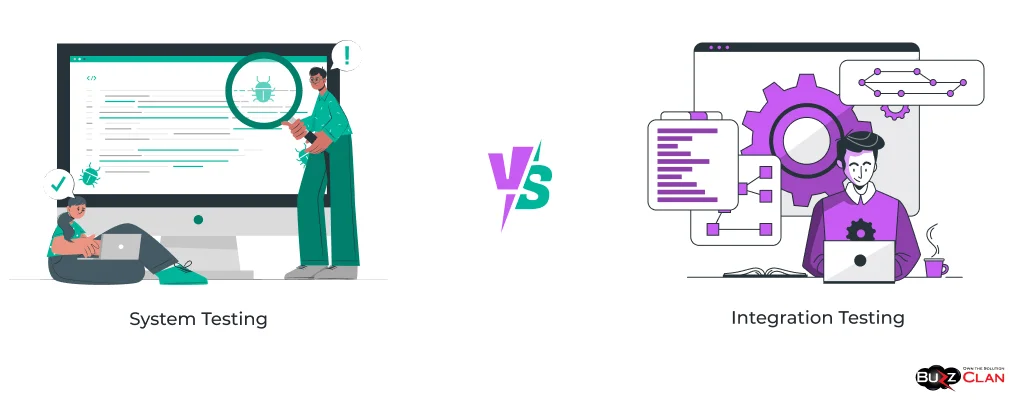
The subsequent level of testing in the software development process is system testing after the completion of integration testing. While integration and system testing are crucial components of the quality assurance process, they have distinct differences.
Integration Testing
Integration testing focuses on verifying that individual modules or components of a software application interact and communicate effectively. It primarily tests the interfaces and interactions between different modules or components. Integration testing ensures that the combined modules function as a cohesive unit.
Key Points about Integration Testing:
- Objective: To verify the interactions and communication between individual modules or components of the software application.
- Scope: Focuses on specific interfaces and interactions between modules or components.
- Focus: Testing the functionality and data exchange between modules.
- Methodology: Integration testing often involves testing different combinations of modules or components to identify potential integration issues.
System Testing
On the other hand, system testing takes a broader perspective and evaluates the entire software system. It aims to validate whether the system meets all the requirements and functions as expected in the intended user environment. System testing encompasses a comprehensive assessment of the system's functional and non-functional aspects.
Key Points about System Testing:
- Objective: To evaluate the complete software system's functionality, performance, and behavior.
- Scope: Encompasses the entire system, including all modules, components, and interactions.
- Focus: Testing the system's compliance with requirements, end-user experience, and overall quality.
- Methodology: System testing often involves testing the system in a simulated user environment or performing real-world scenarios to assess its behavior.
Key Differences Between System Testing and Integration Testing
The fundamental differences between integration testing and system testing can be summarized as follows:
- Scope: Integration testing focuses on individual modules or components, while system testing encompasses the entire software system.
- Objective: Integration testing verifies the interactions between components, while system testing validates the overall functionality and behavior of the system.
- Methodology: Integration testing involves testing specific combinations of modules or components, while system testing typically involves testing the complete system in a simulated or real-world environment.
- Focus: Integration testing emphasizes the technical aspects of module interactions, while system testing considers functional and non-functional aspects, such as usability, performance, and security.
By understanding the distinctions between integration testing and system testing, software development teams can effectively plan, execute, and evaluate the quality of their software applications.
Integration Testing in Different Contexts
Software Integration Testing
Integration testing is critical in software development, where applications are built using multiple modules or components. Different teams may develop these components at different times or use different technologies.
The challenges in software integration testing include:
- Compatibility issues between modules, such as differences in data formats or protocols
- Performance issues when modules are integrated, such as increased response times or resource usage
- Dependency issues, where a change in one module can break functionality in another module
To mitigate these challenges, best practices in software integration testing include:
- Defining clear and consistent interface contracts between modules
- Using stubs and drivers to simulate the behavior of missing or incomplete modules
- Performing incremental integration testing to catch issues early and isolate the cause
- Automating integration tests to ensure consistent and repeatable results
API Integration Testing
In today's interconnected world, APIs (Application Programming Interfaces) enable communication between software systems. API integration testing verifies that these interactions work smoothly and securely.
The challenges in API integration testing include:
- Ensuring compatibility between different versions of the API and its clients
- Handling authentication and authorization to secure the API from unauthorized access
- Validating the correctness and completeness of the data exchanged through the API
Best practices in API integration testing include:
- Using tools like Postman or Swagger to automate API testing
- Developing comprehensive test cases that cover all API endpoints and scenarios
- Performing load testing to verify the API's performance under real-world conditions
- Continuously monitoring the API for availability and responsiveness
Continuous Integration Testing
Continuous Integration (CI) is a software development practice where developers regularly merge code changes into a central repository, triggering an automated build and testing process. Integration testing plays a vital role in this process.
In a CI pipeline, integration tests are automatically run whenever changes are pushed to the repository. This helps catch integration issues early in the development cycle before they can cause problems downstream.
Best practices for integration testing in CI include:
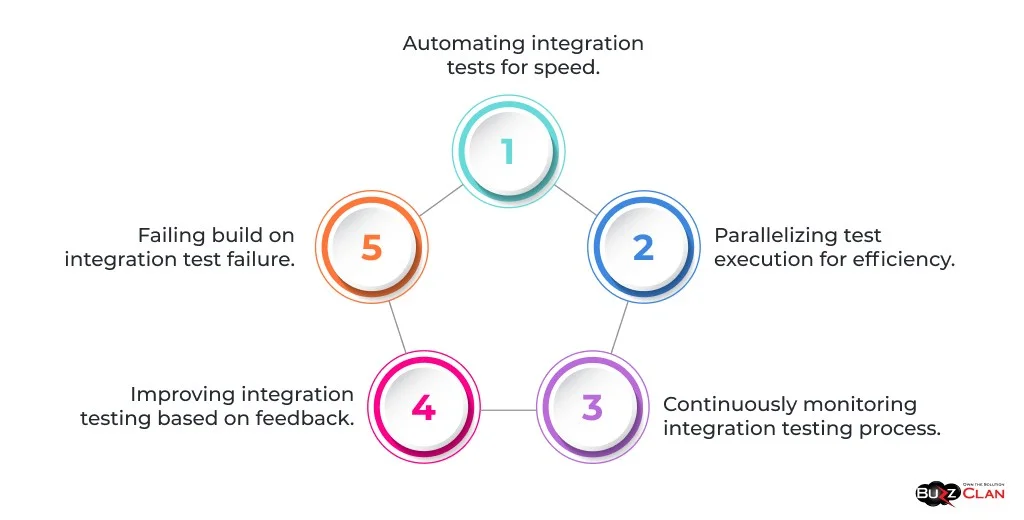
Automating as many integration tests as possible to provide fast feedback:
- Automating integration tests allows for quick and consistent execution, providing immediate feedback on the system's stability and functionality.
- This enables developers to identify and address issues early in the development cycle, reducing the risk of introducing defects into production.
- Automated tests should cover various scenarios and use cases to ensure comprehensive testing.
Parallelizing test execution to reduce the overall runtime of the CI pipeline:
- Parallelizing test execution involves running multiple tests concurrently and utilizing available resources efficiently.
- This technique significantly reduces the overall runtime of the CI pipeline, allowing for faster feedback and quicker release cycles.
- Parallelization can be achieved through various tools and frameworks designed to distribute and execute tests in parallel.
Failing the build if any integration tests fail to prevent broken changes from being merged:
- Failing the build upon integration test failures ensures that broken changes are not accidentally merged into the main codebase.
- This practice enforces code quality and prevents the introduction of defects that could disrupt the system's stability or functionality.
- Developers are notified immediately of failed tests, allowing them to address the issues and promptly ensure the build's success.
Continuously monitoring and improving the integration testing process based on feedback and results:
- Continuously monitoring the integration testing involves tracking test coverage, execution time, and failure rates.
- Analyzing these metrics helps identify areas for improvement and optimize the testing process.
- Regularly reviewing test results and incorporating feedback from developers and stakeholders allows for continuous testing process improvement, ensuring its effectiveness and alignment with changing requirements
Challenges and Solutions in Integration Testing
Common Issues in Integration Testing
While integration testing is essential, it can also be challenging. Some common issues faced during integration testing include:
- Complexity: As the number of modules being integrated increases, the number of possible interactions between them grows exponentially. This can make integration testing a complex and time-consuming process.
- Dependency Management: Integration testing often requires managing dependencies between modules, such as ensuring that the correct versions of each module are being used. This can be challenging, especially in large and complex systems.
- Test Data Management: Preparing test data for integration testing can be difficult, as the data must be consistent across all the tested modules. This can be especially challenging when dealing with large or complex data sets.
- Environment Setup: Setting up the testing environment for integration testing can be complex, as it needs to mimic the production environment as closely as possible. This can involve configuring multiple servers, databases, and other components.
Overcoming Integration Testing Challenges
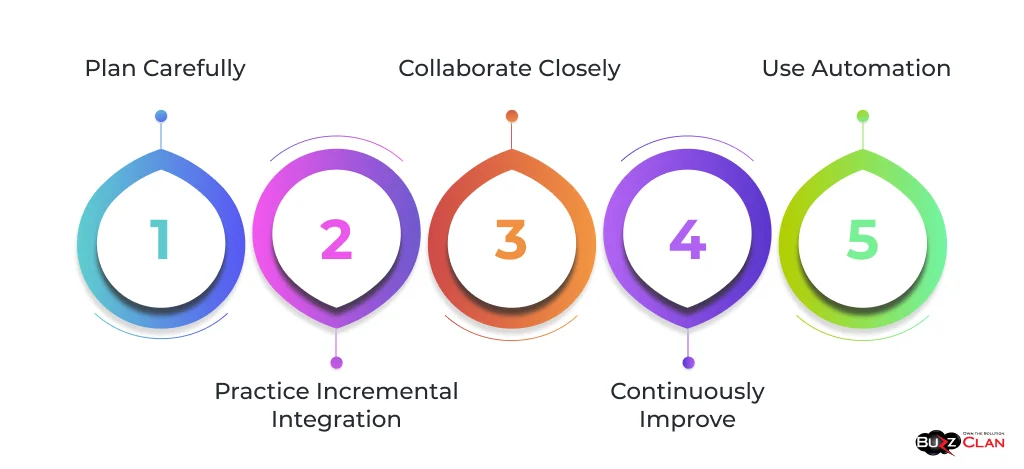
Despite these challenges, there are strategies and best practices that can help teams overcome them and ensure effective integration testing:
- Plan Carefully: Careful planning is essential to successful integration testing. This includes identifying the modules to be tested, defining the test cases and scenarios, and establishing clear success criteria.
- Use Automation: Automated testing tools can significantly reduce the time and effort required for integration testing. These tools can help with test data generation, environment setup, and test execution.
- Practice Incremental Integration: Incremental integration, where modules are integrated and tested one at a time, can help reduce the complexity of integration testing and make it easier to identify and isolate issues.
- Collaborate Closely: Collaboration between development and testing teams is crucial for successful integration testing. This helps ensure that everyone clearly understands the requirements and that any issues are identified and resolved quickly.
- Continuously Improve: Integration testing should be a continuous improvement process. Teams should regularly review and analyze the results of their integration tests and use this feedback to refine and optimize their testing processes.
Advanced Integration Testing
Integration Testing for Complex Systems
As software systems become more complex, integration testing becomes even more critical and challenging. Complex systems often involve multiple subsystems, third-party components, and distributed architectures, all needing to work together seamlessly.
To effectively test these complex systems, teams may need to employ advanced integration testing techniques, such as:
- Service Virtualization: This involves creating simulated versions of external services or components, allowing integration testing to proceed without depending on the availability or stability of these services.
- End-to-End Testing: This type of testing involves verifying data flow and control through the entire system, from the user interface to the back-end systems and databases.
- Distributed Testing: For systems distributed across multiple servers or environments, distributed testing techniques can help ensure that all the components work together correctly.
Performance and Security Integration Testing
In addition to functional correctness, integration testing also needs to verify the performance and security aspects of the integrated system.
Performance integration testing involves verifying that the system meets the required performance standards, such as response time, throughput, and resource utilization. This may involve load testing, stress testing, and other techniques to simulate real-world usage scenarios.
Security integration testing, on the other hand, focuses on identifying and mitigating any security vulnerabilities that may arise from the interaction between modules. This may involve techniques such as penetration testing, fuzz testing, and security audits.
Case Studies and Examples
Real-World Integration Testing
Let's look at some real-world case studies to better understand the practical application of integration testing.
- Healthcare Software: Integration testing is critical in healthcare software systems, where multiple modules (such as electronic health records, billing, and prescription management) must work together seamlessly. Failure to properly integrate these modules could result in serious consequences, such as incorrect patient data or delayed treatments.
- E-commerce Platforms: E-commerce platforms typically involve many components, such as product catalogs, shopping carts, payment gateways, and shipping providers. Integration testing ensures these components work together smoothly to provide a seamless user experience.
- Financial Systems: In financial systems, integration testing is crucial to ensure the accuracy and integrity of financial data across different subsystems, such as accounting, trading, and risk management. Any errors or inconsistencies could lead to significant financial losses.
Integration Testing with Examples
Let's illustrate integration testing with a simple example. Consider an e-commerce application with two modules: a product catalog and a shopping cart. The integration test would verify that:
- When a product is added to the cart from the catalog, it appears correctly.
- When a product is removed from the cart, it is removed correctly, and the total price is updated.
- When the quantity of a product in the cart is changed, the total price is updated correctly.
Here's a simplified example of what an integration test for this scenario might look like:
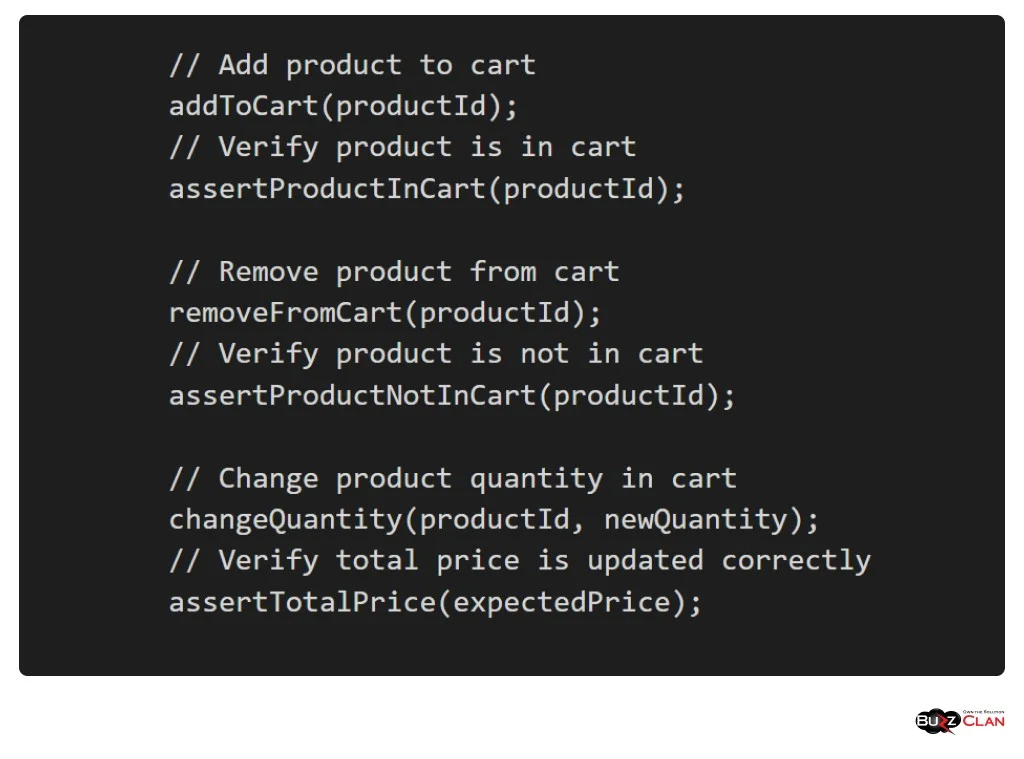
Of course, in a real application, the integration tests would be much more comprehensive, covering all possible scenarios and edge cases.
Conclusion
Integration testing is crucial to ensuring the quality and reliability of software systems. By verifying the interactions between different modules or components, integration testing helps identify and resolve issues that may not be apparent in unit testing alone.
As software systems grow in complexity, the importance of effective integration testing will only increase. By understanding the principles, processes, and best practices of integration testing, software teams can ensure that their systems are reliable, performant, and secure.
Looking forward, we expect to see continued evolution in integration testing practices, with greater adoption of automation, more sophisticated tools and techniques, and increased focus on areas like performance and security testing.
Ultimately, the goal of integration testing remains the same: to deliver high-quality software that meets the needs of users and businesses alike. By unraveling the complexities of integration testing, we can take a significant step towards achieving this goal.
FAQs

Get In Touch
